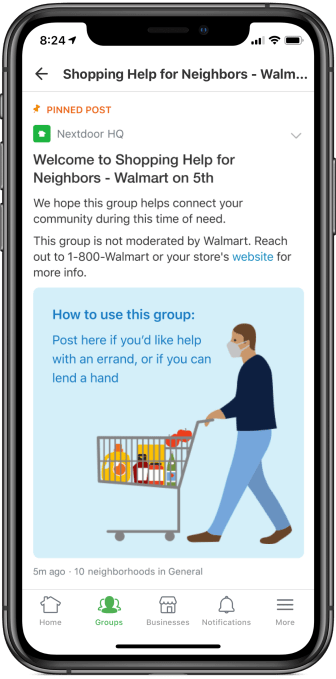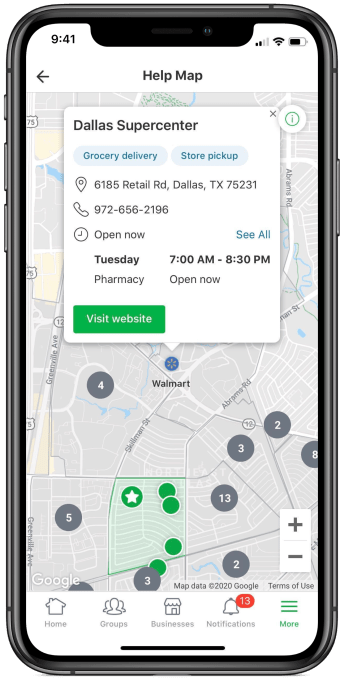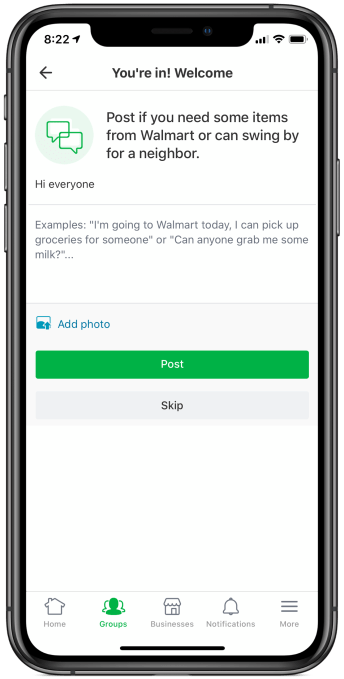Neighborhood social network Nextdoor and Walmart are teaming up today to launch a new “Neighbors Helping Neighbors” program that will make it easier for vulnerable community members to get assistance from neighbors who are already planning a trip to Walmart. The new in-app feature will allow Nextdoor users to post to groups associated with their local Walmart store to request shopping assistance.
To find the new option, Nextdoor users can either use the Nextdoor website or mobile app.
From there, users will click on the “Groups” tab where they’ll see local Walmart stores pinned to the top of the page. Members can then post a message to the group feed where they can ask for help or offer to help others.
Members who connect in the feed can then work out the details on the message board or through direct message, where they can share more private details like their address and what they need from the store.

The feature is designed to help elderly, high-risk or other vulnerable members find someone who will pick up groceries, medications, or other essentials when they’re planning a trip to the store.
This could also offer a low-cost alternative to using online grocery delivery services, which require tipping. In the case of a neighbor helping a neighbor, the assistance is offered on a volunteer basis, not as someone’s job. That could be potentially life-saving for low-income community members who can’t risk shopping in a store during the coronavirus pandemic, but who also struggle to afford alternatives like online grocery.
Walmart isn’t moderating or managing these Nextdoor groups, to be clear, but worked with Nextdoor to make the feature available.
For the retailer, the addition isn’t just beneficial in terms of directing customers to Walmart to shop, it’s also seen as a way to reduce the number of people who come to the store in-person.
“I’ve seen first-hand the countless ways our Walmart team is working together during this challenging time, leading with humanity, compassion and understanding to serve our customers,” said Janey Whiteside, Walmart’s Chief Customer Officer, in a statement about the feature’s launch. “We’re continuing to do that through our new program with Nextdoor. We’re connecting neighbors to each other so that more members of our communities have access to essential items, while limiting contact and the number of people shopping in our stores,” she added.

Nextdoor has launched several new features in response to the coronavirus pandemic in recent weeks.
Its new “Help Maps” allowed members to post and offer help in their neighborhood, for example. But this feature had been buried on the “More” menu in the app and was being underutilized as a result. A dedicated place within Nextdoor Groups for these sorts of requests is more visible, making it easier to offer assistance or to ask for help.
Over the past few weeks, Nextdoor says it’s seen a 7x increase in people joining groups to help one another, a not surprising figure given its recent exit from beta.
Nextdoor will also make the Walmart groups easy to find by pinning them to the top of the Groups tab, it says.
Meanwhile, Walmart store locations and hours where “Neighbors Helping Neighbors” is available can be found on Nextdoor’s “Help Map.”

“We’re inspired everyday by the kindness of people around the world who are stepping up and helping out. In recent weeks, we’ve been blown away by the number of members who have raised their hand to run an errand, go to the grocery store, or pick up a prescription for a neighbor,” said Sarah Friar, Nextdoor CEO, about the feature. “We’re grateful for Walmart’s partnership to make this important connection between neighbors around vital services, and we’re proud to come together to ensure everyone has a neighborhood to rely on,” she said.
The new initiative is launching nationwide starting today, but may not be immediately available in the app as the rollout could take time to complete.



